
Brewster is a town in Barnstable County, Massachusetts, United States, Barnstable County being coextensive with Cape Cod. The population of Brewster was 10,318 at the 2020 census.

The Breakers is a Gilded Age mansion located at 44 Ochre Point Avenue, Newport, Rhode Island, US. It was built between 1893 and 1895 as a summer residence for Cornelius Vanderbilt II, a member of the wealthy Vanderbilt family.

Chateau-sur-Mer is one of the first grand Bellevue Avenue mansions of the Gilded Age in Newport, Rhode Island. Located at 474 Bellevue Avenue, it is now owned by the Preservation Society of Newport County and is open to the public as a museum. Chateau-sur-Mer's grand scale and lavish parties ushered in the Gilded Age of Newport, as it was the most palatial residence in Newport until the Vanderbilt houses in the 1890s. It was designated a National Historic Landmark in 2006.

The John J. Glessner House, operated as the Glessner House, is an architecturally important 19th-century residence located at 1800 S. Prairie Avenue, Chicago, Illinois. Built during the Gilded Age, it was designed in 1885–1886 by architect Henry Hobson Richardson and completed in late 1887. The property was designated a Chicago Landmark on October 14, 1970. The site was listed in the National Register of Historic Places on April 17, 1970, and as a National Historic Landmark on January 7, 1976, and is maintained as a house museum.
Richard Herman Driehaus was an American businessman, investor, and philanthropist. He was the founder, chief investment officer, and chairman of the hedge fund, Driehaus Capital Management LLC, based in Chicago.

The David Davis Mansion, also known as Clover Lawn, is a Gilded Age home in Bloomington, Illinois that was the residence of David Davis, Supreme Court justice (1862–1877) and Senator from Illinois. The mansion has been a state museum since 1960. It was added to the National Register of Historic Places in 1972 and was designated a National Historic Landmark in 1975. In celebration of the 2018 Illinois Bicentennial, David Davis Mansion was selected as one of the Illinois 200 Great Places by the American Institute of Architects Illinois component.

George Washington Maher was an American architect during the first quarter of the 20th century. He is considered part of the Prairie School-style and was known for blending traditional architecture with the Arts & Crafts-style.
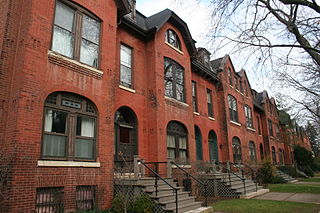
The McCormick Row House District is a group of houses located in the Lincoln Park community area in Chicago, Illinois, USA. It sits between East and West parts of DePaul University's Lincoln Park Campus and is independent from the school. They were built between 1884 and 1889 and used by the McCormick Theological Seminary to gain rental income. They were designed in the Queen Anne Style by the A. M. F. Colton and Son architects and joined the list of Chicago Landmarks May 4, 1971. The McCormick Row House District also lies within the boundaries of the Sheffield Historic District.
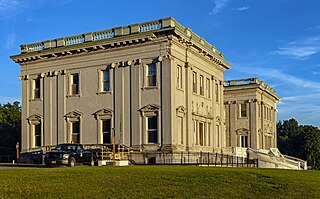
The Staatsburgh State Historic Site preserves a Beaux-Arts mansion designed by McKim, Mead, and White and the home's surrounding landscape in the hamlet of Staatsburg, Dutchess County, New York, United States. The historic site is located within Ogden Mills & Ruth Livingston Mills State Park. The mansion, a New York State Historic Site, is considered a fine example of the great estates built during the Gilded Age.
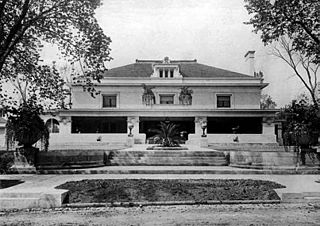
Pleasant Home, also known as the John Farson House, is a historic home located in the Chicago suburb of Oak Park, Illinois, United States. The large, Prairie style mansion was designed by architect George Washington Maher and completed in 1897. The house was added to the U.S. National Register of Historic Places on June 19, 1972. Exactly 24 years later, in 1996, it was declared a National Historic Landmark by the United States Department of the Interior.

The Cable House is a Richardsonian Romanesque-style house near Michigan Avenue at 25 E. Erie St. in Chicago, Illinois, United States. The house was built in 1886 by Cobb and Frost for socialite Ransom R. Cable. It was designated a Chicago Landmark on October 2, 1991.

Nickerson State Park is a state-owned, public recreation area of more than 1,900 acres (770 ha) located on Cape Cod in Brewster, Massachusetts. The park's sandy soil and scrub pines surround many kettle ponds which are dependent on groundwater and precipitation. The largest of these are Cliff Pond, Flax Pond, Little Cliff Pond, and Higgins Pond. Ruth Pond, Keeler's Pond, Eel Pond, and Triangle Pond provide additional water habitats.

Old Higgins Farm Windmill is a historic Smock windmill off of Old King's Highway at Drummer Boy Park in Brewster on Cape Cod in Massachusetts.
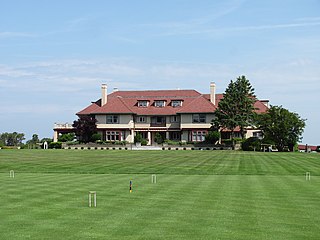
The Nickerson Mansion is a historic house in Brewster, Massachusetts. The large mansion was built in 1907 by Addie Nickerson and her son Samuel on the foundation of an 1890 mansion that was built by Addie's late father-in-law, Samuel Mayo Nickerson, for his son Roland's family to use as a summer home. The building's interior was lavishly appointed with Italian marble and hand-carved woodwork. The Nickersons owned the property until 1945, when it was purchased by the Missionaries of La Salette, who used it as a seminary. It is now one of the centerpieces of the Ocean Edge Resort under the name "The Mansion at Ocean Edge".
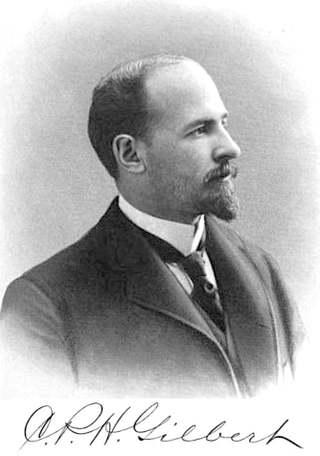
Charles Pierrepont Henry Gilbert was an American architect of the late-19th and early-20th centuries best known for designing townhouses and mansions.
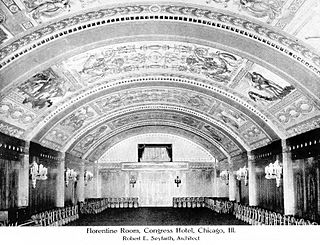
Robert Seyfarth was an American architect based in Chicago, Illinois. He spent the formative years of his professional career working for the noted Prairie School architect George Washington Maher. A member of the influential Chicago Architectural Club, Seyfarth was a product of the Chicago School of Architecture.

Prairie Avenue is a north–south street on the South Side of Chicago, which historically extended from 16th Street in the Near South Side to the city's southern limits and beyond. The street has a rich history from its origins as a major trail for horseback riders and carriages. During the last three decades of the 19th century, a six-block section of the street served as the residence of many of Chicago's elite families and an additional four-block section was also known for grand homes. The upper six-block section includes part of the historic Prairie Avenue District, which was declared a Chicago Landmark and added to the National Register of Historic Places.
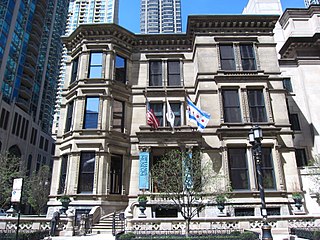
The Richard H. Driehaus Museum is a museum located at 40 East Erie Street on the Near North Side in Chicago, Illinois, near the Magnificent Mile. The museum is housed within the historic Samuel M. Nickerson House, the 1883 residence of a wealthy Chicago banker. Although the mansion has been restored, the Driehaus Museum does not re-create the Nickerson period but rather broadly interprets and displays the prevailing design, architecture, and decorating tastes of Gilded Age America and the art nouveau era in permanent and special exhibitions.





















